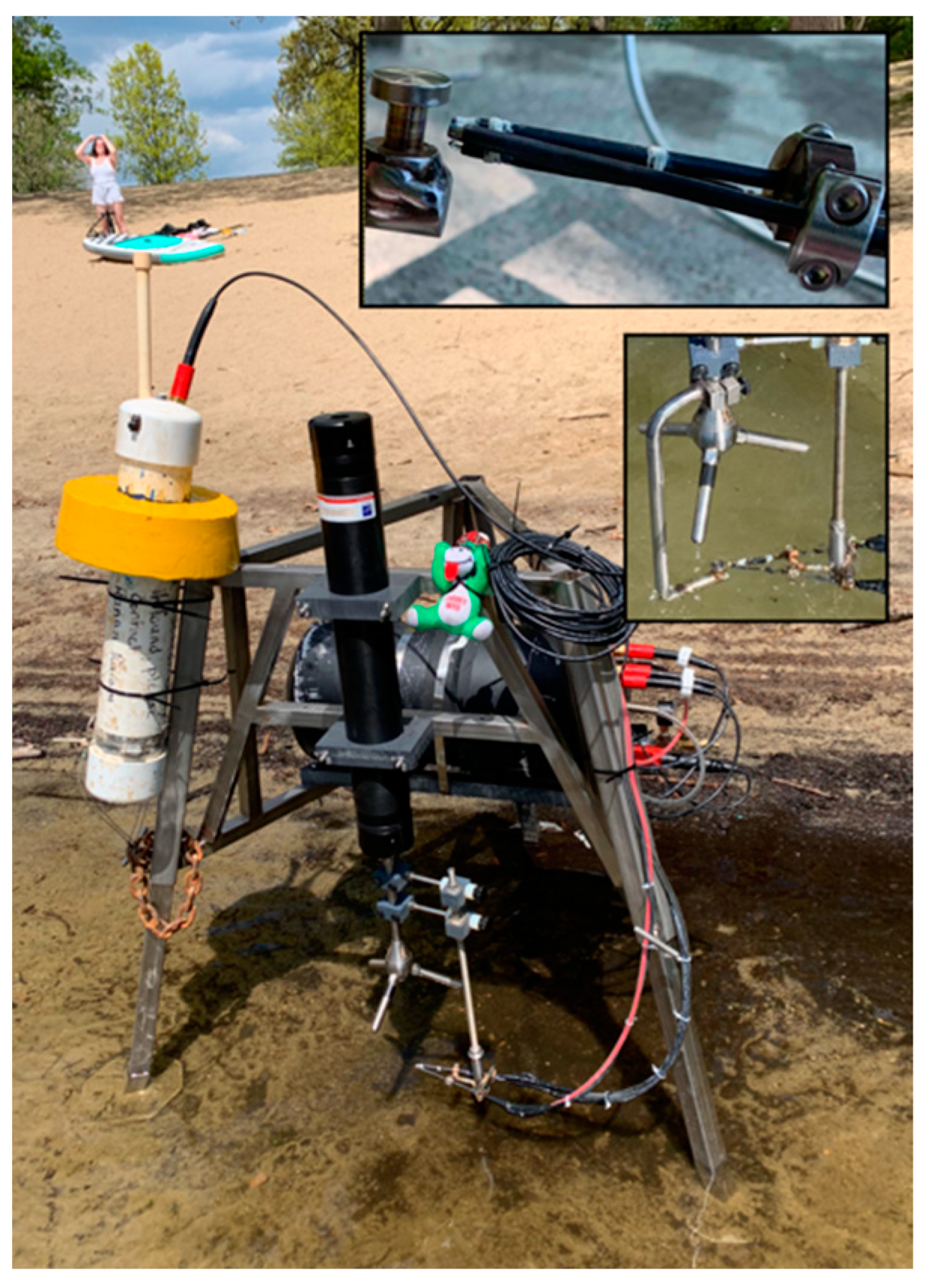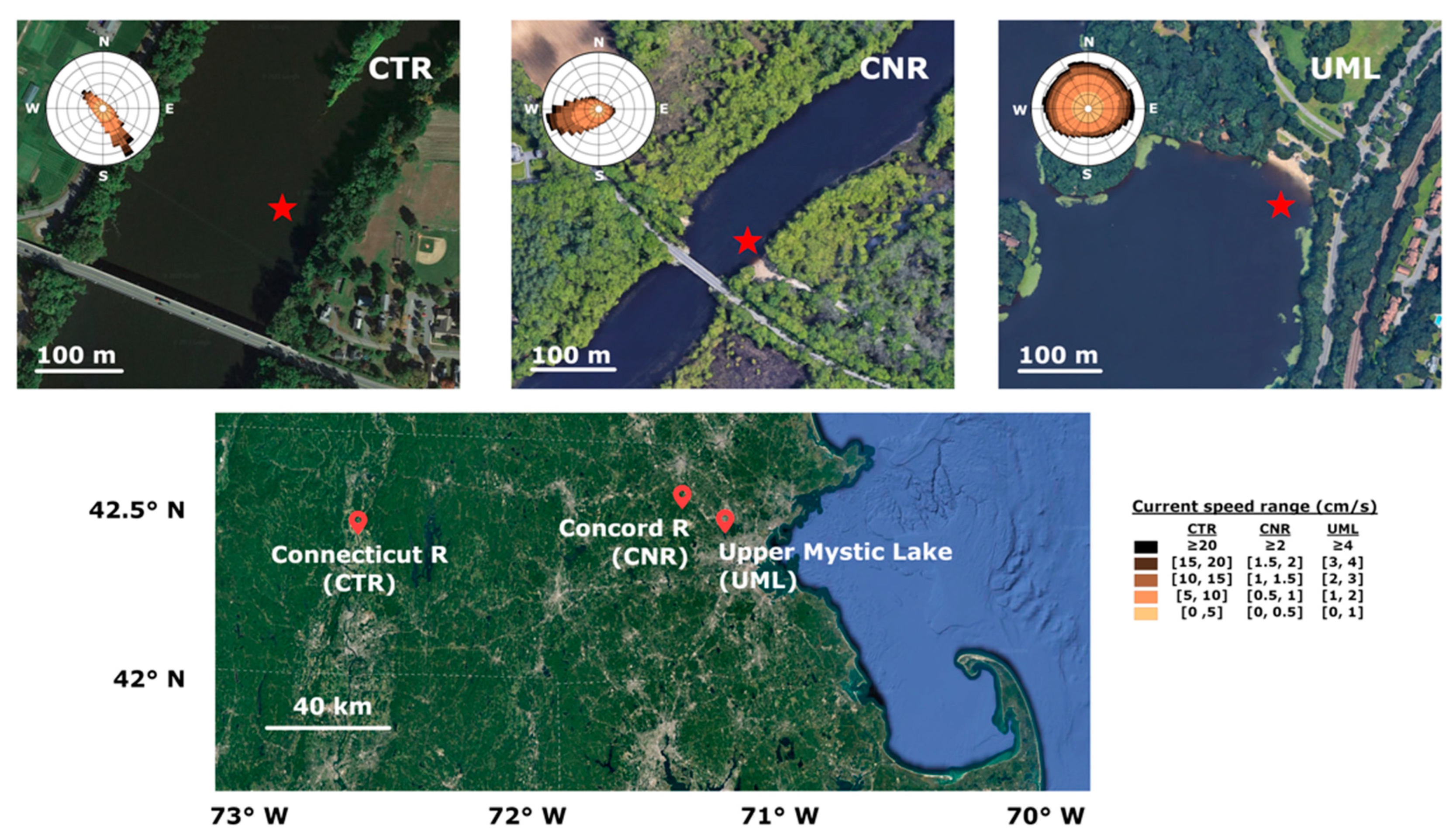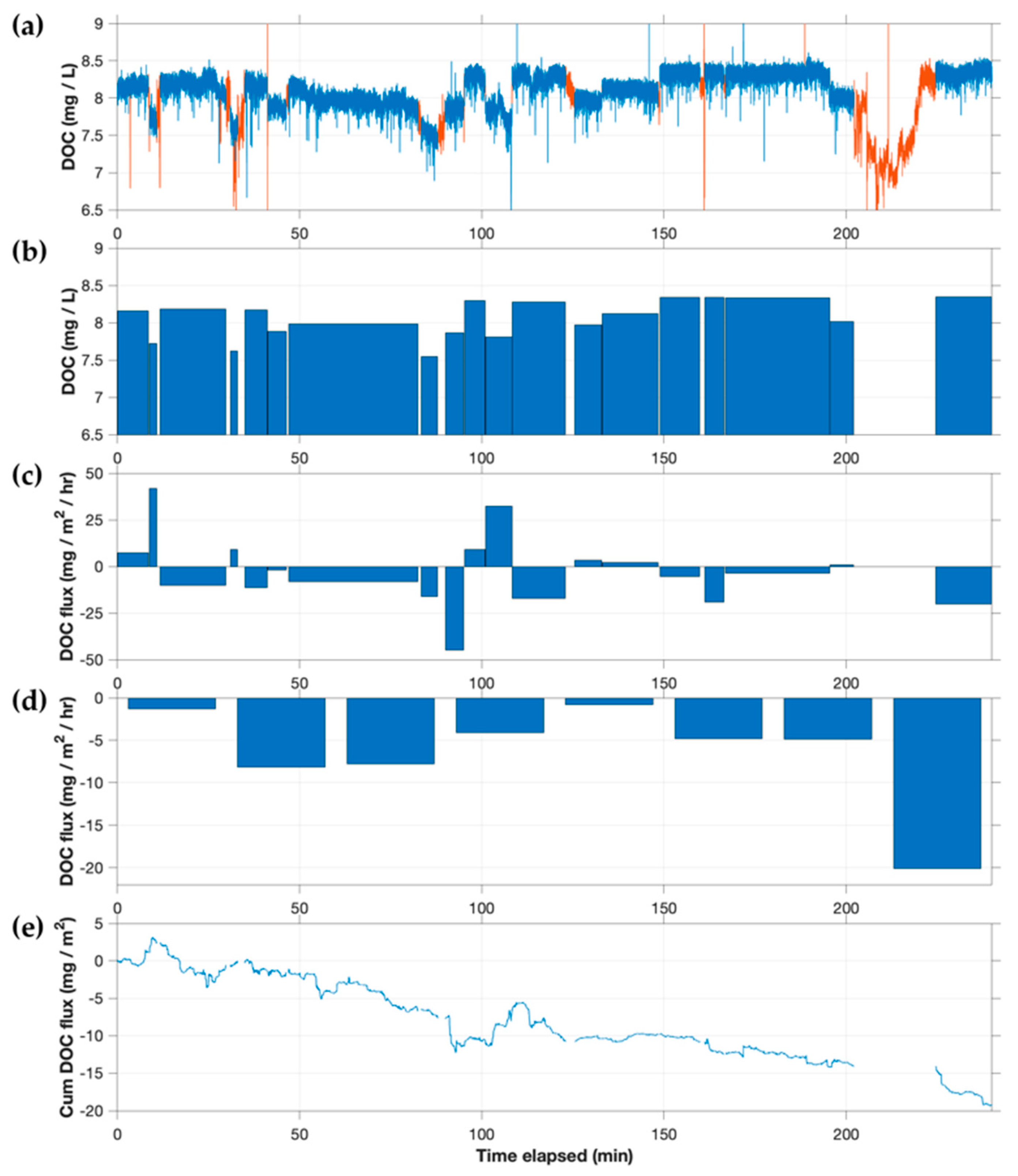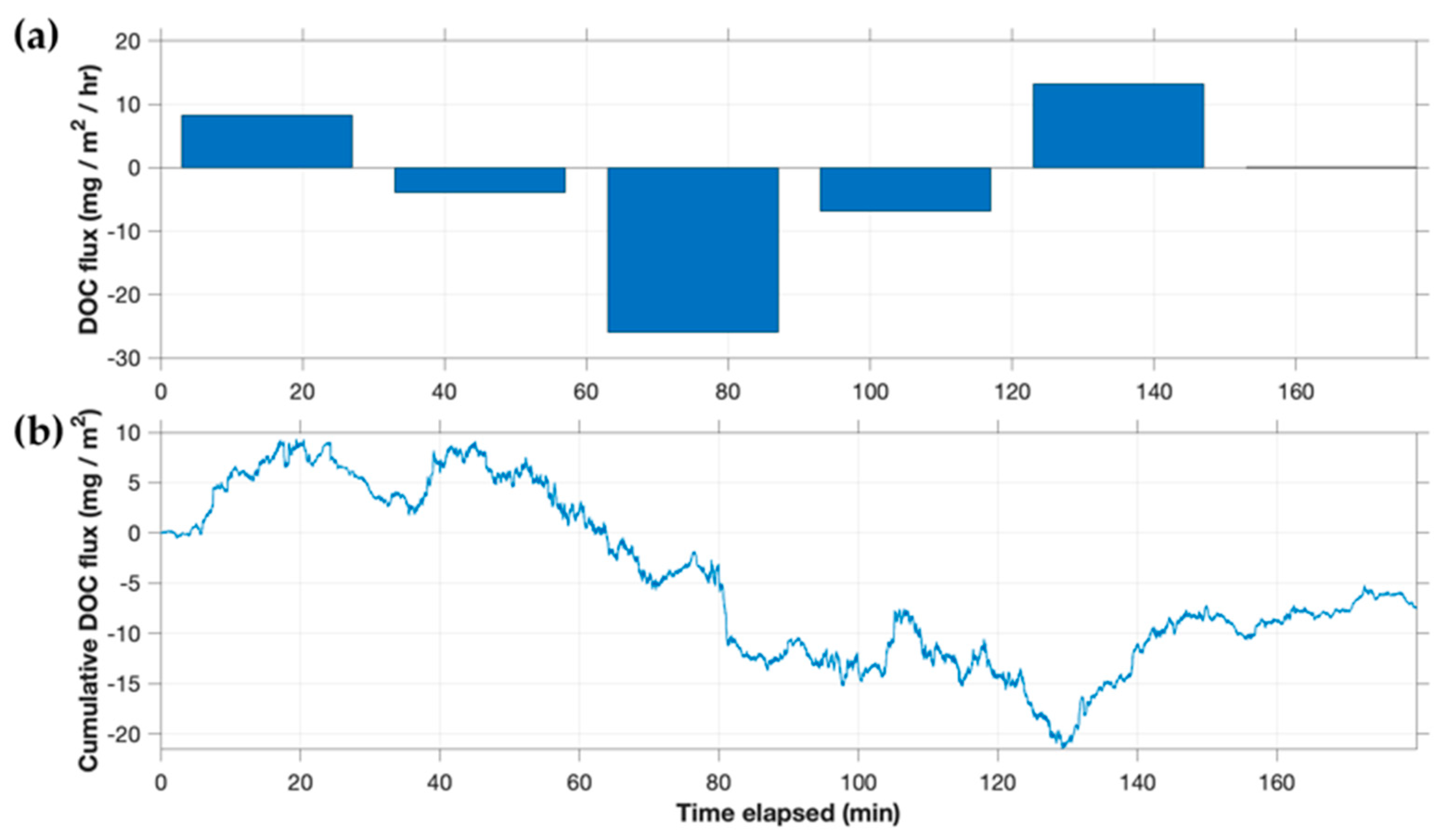Benthic Fluxes of Fluorescent Dissolved Organic Material, Salt, and Heat Measured by Multiple-Sensor Aquatic Eddy Covariance
Abstract
:1. Introduction
2. Materials and Methods
2.1. Instrumentation
2.2. Data Analysis
2.3. Seepage Rates, Temperature Profiles, Solar Radiation, Porewater Samples, TOC, Conductivity
2.4. Heat Flux Measurement
2.5. Salt Flux Measurement
2.6. Field Deployments
3. Results
3.1. Deployment Conditions
3.2. Velocity Data Quality
3.3. Concentration Measurements
3.4. Eddy Fluxes of Salinity
3.5. Eddy Fluxes of Heat
3.6. Eddy Fluxes of DOC
4. Discussion
4.1. Salt Fluxes
4.2. Heat Fluxes
4.3. DOC Fluxes
4.3.1. Ambient Light Effects
4.3.2. FDOM vs. DOC
4.3.3. A Biotic Sink for DOC at the Concord River
5. Conclusions
5.1. Synergism among Sensor Channels
5.2. Tracer Techniques for other Biogeochemicals and Pollutants
5.3. DOC Fluxes, and the Utility of a Fast Spectrofluorometric Sensor
5.4. Instrument Development
Supplementary Materials
Author Contributions
Funding
Informed Consent Statement
Data Availability Statement
Acknowledgments
Conflicts of Interest
References
- Berg, P.; Røy, H.; Janssen, F.; Meyer, V.; Jørgensen, B.; Huettel, M.; de Beer, D. Oxygen Uptake by Aquatic Sediments Measured with a Novel Non-Invasive Eddy-Correlation Technique. Mar. Ecol. Prog. Ser. 2003, 261, 75–83. [Google Scholar] [CrossRef]
- Berg, P.; Huettel, M.; Glud, R.N.; Reimers, C.E.; Attard, K.M. Aquatic Eddy Covariance: The Method and Its Contributions to Defining Oxygen and Carbon Fluxes in Marine Environments. Ann. Rev. Mar. Sci. 2021, 14, 431–455. [Google Scholar] [CrossRef] [PubMed]
- Crusius, J.; Berg, P.; Koopmans, D.J.; Erban, L. Eddy Correlation Measurements of Submarine Groundwater Discharge. Mar. Chem. 2008, 109, 77–85. [Google Scholar] [CrossRef]
- McGinnis, D.F.; Cherednichenko, S.; Sommer, S.; Berg, P.; Rovelli, L.; Schwarz, R.; Glud, R.N.; Linke, P. Simple, Robust Eddy Correlation Amplifier for Aquatic Dissolved Oxygen and Hydrogen Sulfide Flux Measurements. Limnol. Oceanogr. Methods 2011, 9, 340–347. [Google Scholar] [CrossRef] [Green Version]
- Johnson, K.S.; Barry, J.P.; Coletti, L.J.; Fitzwater, S.E.; Jannasch, H.W.; Love, C.F. Nitrate and Oxygen Flux across the Sediment-Water Interface Observed by Eddy Correlation Measurements on the Open Continental Shelf. Limnol. Oceanogr. Methods 2011, 9, 543–553. [Google Scholar] [CrossRef]
- Long, M.H.; Charette, M.A.; Martin, W.R.; McCorkle, D.C. Oxygen Metabolism and PH in Coastal Ecosystems: Eddy Covariance Hydrogen Ion and Oxygen Exchange System (ECHOES). Limnol. Oceanogr. Methods 2015, 13, 438–450. [Google Scholar] [CrossRef]
- Koopmans, D.J.; Meyer, V.; Schaap, A.; Dewar, M.; Färber, P.; Long, M.; Gros, J.; Connelly, D.; Holtappels, M. Detection and Quantification of a Release of Carbon Dioxide Gas at the Seafloor Using PH Eddy Covariance and Measurements of Plume Advection. Int. J. Greenh. Gas Control 2021, 112, 103476. [Google Scholar] [CrossRef]
- Hu, I.H.; Hemond, H.F. A Multi-Function Sensor for Eddy Correlation Measurements of Benthic Flux. IEEE Sens. J. 2020, 20, 1509–1526. [Google Scholar] [CrossRef]
- Ferrari, G.M.; Dowell, M.D.; Grossi, S.; Targa, C. Relationship between the Optical Properties of Chromophoric Dissolved Organic Matter and Total Concentration of Dissolved Organic Carbon in the Southern Baltic Sea Region. Mar. Chem. 1996, 55, 299–316. [Google Scholar] [CrossRef]
- Ferrari, G.M. The Relationship between Chromophoric Dissolved Organic Matter and Dissolved Organic Carbon in the European Atlantic Coastal Area and in the West Mediterranean Sea (Gulf of Lions). Mar. Chem. 2000, 70, 339–357. [Google Scholar] [CrossRef]
- Burdige, D.J.; Kline, S.W.; Chen, W. Fluorescent Dissolved Organic Matter in Marine Sediment Pore Waters. Mar. Chem. 2004, 89, 289–311. [Google Scholar] [CrossRef]
- Downing, B.D.; Bergamaschi, B.A.; Evans, D.G.; Boss, E. Assessing Contribution of DOC from Sediments to a Drinking-Water Reservoir Using Optical Profiling. Lake Reserv. Manag. 2008, 24, 381–391. [Google Scholar] [CrossRef] [Green Version]
- Dadi, T.; Friese, K.; Wendt-Potthoff, K.; Koschorreck, M. Benthic Dissolved Organic Carbon Fluxes in a Drinking Water Reservoir. Limnol. Oceanogr. 2016, 61, 445–459. [Google Scholar] [CrossRef] [Green Version]
- Holcombe, B.L.; Keil, R.G.; Devol, A.H. Determination of Pore-Water Dissolved Organic Carbon Fluxes from Mexican Margin Sediments. Limnol. Oceanogr. 2001, 46, 298–308. [Google Scholar] [CrossRef]
- Maher, D.T.; Eyre, B.D. Benthic Fluxes of Dissolved Organic Carbon in Three Temperate Australian Estuaries: Implications for Global Estimates of Benthic DOC Fluxes. J. Geophys. Res. 2010, 115, G04039. [Google Scholar] [CrossRef]
- Burnett, W.C.; Aggarwal, P.K.; Aureli, A.; Bokuniewicz, H.; Cable, J.E.; Charette, M.A.; Kontar, E.; Krupa, S.; Kulkarni, K.M.; Loveless, A.; et al. Quantifying Submarine Groundwater Discharge in the Coastal Zone via Multiple Methods. Sci. Total Environ. 2006, 367, 498–543. [Google Scholar] [CrossRef]
- Berg, P.; Koopmans, D.J.; Huettel, M.; Li, H.; Mori, K.; Wüest, A. A New Robust Oxygen-Temperature Sensor for Aquatic Eddy Covariance Measurements. Limnol. Oceanogr. Methods 2016, 14, 151–167. [Google Scholar] [CrossRef] [Green Version]
- Reimers, C.E.; Sanders, R.D.; Dewey, R.; Noel, R. Benthic Fluxes of Oxygen and Heat from a Seasonally Hypoxic Region of Saanich Inlet Fjord Observed by Eddy Covariance. Estuar. Coast. Shelf Sci. 2020, 243, 106815. [Google Scholar] [CrossRef]
- Berg, P.; Pace, M.L. Continuous Measurement of Air–Water Gas Exchange by Underwater Eddy Covariance. Biogeosciences 2017, 14, 5595–5606. [Google Scholar] [CrossRef] [Green Version]
- Donis, D.; Holtappels, M.; Noss, C.; Cathalot, C.; Hancke, K.; Polsenaere, P.; Wenzhöfer, F.; Lorke, A.; Meysman, F.J.R.; Glud, R.N.; et al. An Assessment of the Precision and Confidence of Aquatic Eddy Correlation Measurements. J. Atmos. Ocean. Technol. 2015, 32, 642–655. [Google Scholar] [CrossRef]
- Merikhi, A.; Berg, P.; Huettel, M. Technical Note: Novel Triple O2 Sensor Aquatic Eddy Covariance Instrument with Improved Time Shift Correction Reveals Central Role of Microphytobenthos for Carbon Cycling in Coral Reef Sands. Biogeosciences 2021, 18, 5381–5395. [Google Scholar] [CrossRef]
- Gardner, A.T.; Karam, H.N.; Mulligan, A.E.; Harvey, C.F.; Hammar, T.R.; Hemond, H.F. A Differential Pressure Instrument with Wireless Telemetry for In-Situ Measurement of Fluid Flow across Sediment-Water Boundaries. Sensors 2009, 9, 404–429. [Google Scholar] [CrossRef] [PubMed] [Green Version]
- Holtappels, M.; Kuypers, M.M.M.; Schlueter, M.; Bruchert, V. Measurement and Interpretation of Solute Concentration Gradients in the Benthic Boundary Layer. Limnol. Oceanogr. Methods 2011, 9, 1–13. [Google Scholar] [CrossRef] [Green Version]
- Rheuban, J.E.; Berg, P. The Effects of Spatial and Temporal Variability at the Sediment Surface on Aquatic Eddy Correlation Flux Measurements. Limnol. Oceanogr. Methods 2013, 11, 351–359. [Google Scholar] [CrossRef] [Green Version]
- Holtappels, M.; Glud, R.N.; Donis, D.; Liu, B.; Hume, A.C.; Wenzhöfer, F.; Kuypers, M.M.M. Effects of Transient Bottom Water Currents and Oxygen Concentrations on Benthic Exchange Rates as Assessed by Eddy Correlation Measurements. J. Geophys. Res. Ocean. 2013, 118, 1157–1169. [Google Scholar] [CrossRef]
- Jenway. AN A02-001A: The Effect of Temperature on Conductivity Measurement; Cole Parmer Inc.: Vernon Hills, IL, USA, 2009. [Google Scholar]
- Goring, D.G.; Nikora, V.I. Despiking Acoustic Doppler Velocimeter Data. J. Hydraul. Eng. 2002, 128, 117–126. [Google Scholar] [CrossRef] [Green Version]
- Rusello, P.J. TN-027: A Practical Primer for Pulse Coherent Instruments; NortekUSA: Boston, MA, USA, 2009. [Google Scholar]
- Wilczak, J.M.; Oncley, S.P.; Stage, S.A. Sonic Anemometer Tilt Correction Algorithms. Bound. Layer Meteorol. 2001, 99, 127–150. [Google Scholar] [CrossRef]
- Lorke, A.; McGinnis, D.F.; Maeck, A. Eddy-Correlation Measurements of Benthic Fluxes under Complex Flow Conditions: Effects of Coordinate Transformations and Averaging Time Scales. Limnol. Oceanogr. Methods 2013, 11, 425–437. [Google Scholar] [CrossRef]
- Lee, D.R. A Device for Measuring Seepage Flux in Lakes and Estuaries1. Limnol. Oceanogr. 1977, 22, 140–147. [Google Scholar] [CrossRef]
- Berg, P.; Røy, H.; Wiberg, P.L. Eddy Correlation Flux Measurements: The Sediment Surface Area That Contributes to the Flux. Limnol. Oceanogr. 2007, 52, 1672–1684. [Google Scholar] [CrossRef]
- Thimijan, R.W.; Heins, R.D. Photometric, Radiometric, and Quantum Light Units of Measure: A Review of Procedures for Interconversion. HortScience 1983, 18, 818–820. [Google Scholar] [CrossRef]
- Benoit, G.; Hemond, H.F. Vertical Eddy Diffusion Calculated by the Flux Gradient Method: Significance of Sediment-Water Heat Exchange. Limnol. Oceanogr. 1996, 41, 157–168. [Google Scholar] [CrossRef] [Green Version]
- Dahaan, S.; Al-Ansari, N.; Knutsson, S. Influence of Groundwater Hypothetical Salts on Electrical Conductivity Total Dissolved Solids. Engineering 2016, 8, 823–830. [Google Scholar] [CrossRef] [Green Version]
- Varadharajan, C.; Hemond, H.F. Time-Series Analysis of High-Resolution Ebullition Fluxes from a Stratified, Freshwater Lake. J. Geophys. Res. Biogeosci. 2012, 117, 1–15. [Google Scholar] [CrossRef]
- Reimers, C.E.; Özkan-Haller, H.T.; Albright, A.T.; Berg, P. Microelectrode Velocity Effects and Aquatic Eddy Covariance Measurements under Waves. J. Atmos. Ocean. Technol. 2016, 33, 263–282. [Google Scholar] [CrossRef]
- Russoniello, C.J.; Fernandez, C.; Bratton, J.F.; Banaszak, J.F.; Krantz, D.E.; Andres, A.S.; Konikow, L.F.; Michael, H.A. Geologic Effects on Groundwater Salinity and Discharge into an Estuary. J. Hydrol. 2013, 498, 1–12. [Google Scholar] [CrossRef]
- Frape, S.K.; Patterson, R.J. Chemistry of Interstitial Water and Bottom Sediments as Indicators of Seepage Patterns in Perch Lake, Chalk River, Ontario. Limnol. Oceanogr. 1981, 26, 500–517. [Google Scholar] [CrossRef]
- Hu, I.; Hemond, H. Sensing Volume and Bandwidth Characteristics of a Multi-Function Sensor for Eddy Correlation Measurements of Benthic Flux. In Proceedings of the Oceans 2019 MTS/IEEE Seattle, Seattle, WA, USA, 27–31 October 2019; IEEE: Piscataway, NJ, USA, 2019; pp. 1–8. [Google Scholar] [CrossRef]
- Hamamatsu Photonics. Photomultiplier Tubes: Basics and Applications, 3rd ed.; Hamamatsu Photonics: Hamamatsu, Japan, 2007. [Google Scholar]
- Berg, P.; Glud, R.N.; Hume, A.C.; Stahl, H.; Oguri, K.; Meyer, V.; Kitazato, H. Eddy Correlation Measurements of Oxygen Uptake in Deep Ocean Sediments. Limnol. Oceanogr. Methods 2009, 7, 576–584. [Google Scholar] [CrossRef] [Green Version]
- Berg, P.; Long, M.H.; Huettel, M.; Rheuban, J.E.; McGlathery, K.J.; Howarth, R.W.; Foreman, K.H.; Giblin, A.E.; Marino, R. Eddy Correlation Measurements of Oxygen Fluxes in Permeable Sediments Exposed to Varying Current Flow and Light. Limnol. Oceanogr. 2013, 58, 1329–1343. [Google Scholar] [CrossRef]
- Coble, P.G. Characterization of Marine and Terrestrial DOM in Seawater Using Excitation-Emission Matrix Spectroscopy. Mar. Chem. 1996, 51, 325–346. [Google Scholar] [CrossRef]
- Fellman, J.B.; Hood, E.; Spencer, R.G.M. Fluorescence Spectroscopy Opens New Windows into Dissolved Organic Matter Dynamics in Freshwater Ecosystems: A Review. Limnol. Oceanogr. 2010, 55, 2452–2462. [Google Scholar] [CrossRef]
- Skoog, A.; Hall, P.O.J.; Hulth, S.; Paxéus, N.; Rutgers Van Der Loeff, M.; Westerlund, S. Early Diagenetic Production and Sediment-Water Exchange of Fluorescent Dissolved Organic Matter in the Coastal Environment. Geochim. Cosmochim. Acta 1996, 60, 3619–3629. [Google Scholar] [CrossRef]
- Fellman, J.B.; Hood, E.; D’Amore, D.v.; Edwards, R.T.; White, D. Seasonal Changes in the Chemical Quality and Biodegradability of Dissolved Organic Matter Exported from Soils to Streams in Coastal Temperate Rainforest Watersheds. Biogeochemistry 2009, 95, 277–293. [Google Scholar] [CrossRef]
- Yang, L.; Choi, J.H.; Hur, J. Benthic Flux of Dissolved Organic Matter from Lake Sediment at Different Redox Conditions and the Possible Effects of Biogeochemical Processes. Water Res. 2014, 61, 97–107. [Google Scholar] [CrossRef]
- Ishii, S.K.L.; Boyer, T.H. Behavior of Reoccurring PARAFAC Components in Fluorescent Dissolved Organic Matter in Natural and Engineered Systems: A Critical Review. Environ. Sci Technol. 2012, 46, 2006–2017. [Google Scholar] [CrossRef]
- Allan, J.D.; Castillo, M.M.; Capps, K.A. Detrital Energy and the Decomposition of Organic Matter. In Stream Ecology; Springer: Cham, Switzerland, 2021; pp. 177–224. [Google Scholar] [CrossRef]
- Burdige, D.J.; Alperin, M.J.; Homstead, J.; Martens, C.S. The Role of Benthic Fluxes of Dissolved Organic Carbon in Oceanic and Sedimentary Carbon Cycling. Geophys. Res. Lett. 1992, 19, 1851–1854. [Google Scholar] [CrossRef] [Green Version]
- Sobczak, W.; Findlay, S. Variation in Bioavailability of Dissolved Organic Carbon Among Stream Hyporheic Flowpaths. Ecology 2002, 83, 3194–3209. [Google Scholar] [CrossRef]
- Boto, K.; Alongi, D.; Nott, A. Dissolved Organic Carbon-Bacteria Interactions at Sediment-Water Interface in a Tropical Mangrove System. Mar. Ecol. Prog. Ser. 1989, 51, 243–251. [Google Scholar] [CrossRef]
- Findlay, S.; Strayer, D.; Goumbala, C.; Gould, K. Metabolism of Streamwater Dissolved Organic Carbon in the Shallow Hyporheic Zone. Limnol. Oceanogr. 1993, 38, 1493–1499. [Google Scholar] [CrossRef]
- Brailsford, F.L.; Glanville, H.C.; Golyshin, P.N.; Johnes, P.J.; Yates, C.A.; Jones, D.L. Microbial Uptake Kinetics of Dissolved Organic Carbon (DOC) Compound Groups from River Water and Sediments. Sci. Rep. 2019, 9, 11229. [Google Scholar] [CrossRef] [Green Version]
- Pollard, P.C. In Situ Rapid Measures of Total Respiration Rate Capture the Super Labile DOC Bacterial Substrates of Freshwater. Limnol. Oceanogr. Methods 2013, 11, 584–593. [Google Scholar] [CrossRef] [Green Version]
- Mineau, M.M.; Wollheim, W.M.; Buffam, I.; Findlay, S.E.G.; Hall, R.O.; Hotchkiss, E.R.; Koenig, L.E.; McDowell, W.H.; Parr, T.B. Dissolved Organic Carbon Uptake in Streams: A Review and Assessment of Reach-Scale Measurements. J. Geophys. Res. Biogeosci. 2016, 121, 2019–2029. [Google Scholar] [CrossRef] [Green Version]
- Li, A.; Drummond, J.D.; Bowen, J.C.; Cory, R.M.; Kaplan, L.A.; Packman, A.I. Effect of Decreasing Biological Lability on Dissolved Organic Matter Dynamics in Streams. Water Resour. Res. 2021, 57, e2020WR027918. [Google Scholar] [CrossRef]
- Billett, M.F.; Charman, D.J.; Clark, J.M.; Evans, C.D.; Evans, M.G.; Ostle, N.J.; Worrall, F.; Burden, A.; Dinsmore, K.J.; Jones, T.; et al. Carbon Balance of UK Peatlands: Current State of Knowledge and Future Research Challenges. Clim. Res. 2010, 45, 13–29. [Google Scholar] [CrossRef] [Green Version]
- Nelson, C.E.; Donahue, M.J.; Dulaiova, H.; Goldberg, S.J.; la Valle, F.F.; Lubarsky, K.; Miyano, J.; Richardson, C.; Silbiger, N.J.; Thomas, F.I.M. Fluorescent Dissolved Organic Matter as a Multivariate Biogeochemical Tracer of Submarine Groundwater Discharge in Coral Reef Ecosystems. Mar. Chem. 2015, 177, 232–243. [Google Scholar] [CrossRef] [Green Version]
- Attard, K.; Stahl, H.; Kamenos, N.; Turner, G.; Burdett, H.; Glud, R. Benthic Oxygen Exchange in a Live Coralline Algal Bed and an Adjacent Sandy Habitat: An Eddy Covariance Study. Mar. Ecol. Prog. Ser. 2015, 535, 99–115. [Google Scholar] [CrossRef] [Green Version]
- Ziegler, S.; Benner, R. Dissolved Organic Carbon Cycling in a Subtropical Seagrass-Dominated Lagoon. Mar. Ecol. Prog. Ser. 1999, 180, 149–160. [Google Scholar] [CrossRef] [Green Version]
- Barrón, C.; Apostolaki, E.T.; Duarte, C.M. Dissolved Organic Carbon Fluxes by Seagrass Meadows and Macroalgal Beds. Front. Mar. Sci. 2014, 1, 42. [Google Scholar] [CrossRef]
- Quinlan, Z.A.; Remple, K.; Fox, M.D.; Silbiger, N.J.; Oliver, T.A.; Putnam, H.M.; Kelly, L.W.; Carlson, C.A.; Donahue, M.J.; Nelson, C.E. Fluorescent Organic Exudates of Corals and Algae in Tropical Reefs Are Compositionally Distinct and Increase with Nutrient Enrichment. Limnol. Oceanogr. Lett. 2018, 3, 331–340. [Google Scholar] [CrossRef]
- Kelly, L.W.; Nelson, C.E.; Petras, D.; Koester, I.; Quinlan, Z.A.; Arts, M.G.I.; Nothias, L.-F.; Comstock, J.; White, B.M.; Hopmans, E.C.; et al. Distinguishing the Molecular Diversity, Nutrient Content, and Energetic Potential of Exometabolomes Produced by Macroalgae and Reef-Building Corals. Proc. Natl. Acad. Sci. USA 2022, 119, e2110283119. [Google Scholar] [CrossRef]
- Wasswa, J.; Mladenov, N.; Pearce, W. Assessing the Potential of Fluorescence Spectroscopy to Monitor Contaminants in Source Waters and Water Reuse Systems. Environ. Sci. 2019, 5, 370–382. [Google Scholar] [CrossRef] [Green Version]
- Sinfield, J.V.; Hemond, H.F.; Germaine, J.T.; Johnson, B.; Bloch, J. Contaminant Detection, Identification, and Quantification Using a Microchip Laser Fluorescence Sensor. J. Environ. Eng. 2007, 133, 346–351. [Google Scholar] [CrossRef]










Publisher’s Note: MDPI stays neutral with regard to jurisdictional claims in published maps and institutional affiliations. |
© 2022 by the authors. Licensee MDPI, Basel, Switzerland. This article is an open access article distributed under the terms and conditions of the Creative Commons Attribution (CC BY) license (https://creativecommons.org/licenses/by/4.0/).
Share and Cite
Hu, I.H.; Hemond, H.F. Benthic Fluxes of Fluorescent Dissolved Organic Material, Salt, and Heat Measured by Multiple-Sensor Aquatic Eddy Covariance. Sensors 2022, 22, 8984. https://doi.org/10.3390/s22228984
Hu IH, Hemond HF. Benthic Fluxes of Fluorescent Dissolved Organic Material, Salt, and Heat Measured by Multiple-Sensor Aquatic Eddy Covariance. Sensors. 2022; 22(22):8984. https://doi.org/10.3390/s22228984
Chicago/Turabian StyleHu, Irene H., and Harold F. Hemond. 2022. "Benthic Fluxes of Fluorescent Dissolved Organic Material, Salt, and Heat Measured by Multiple-Sensor Aquatic Eddy Covariance" Sensors 22, no. 22: 8984. https://doi.org/10.3390/s22228984




